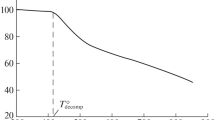Summary
The interfacial tensions of a series of poly(ethylene oxides) (PEO) and poly(propylene oxides) (PPO) have been measured using a pendant drop technique. A drop of PEO was formed under the PPO, in a thermostatted cell usually at 73 °C, and it was photographed using parallel monochromatic light from a laser.
The interfacial tensions were measured for a series of polymers of different molecular weights and were found to increase with increasing PPO molecular weight but to decrease slightly with increasing PEO molecular weight. The dependence on PPO molecular weight is explained as due to the adsorption of hydroxy end groups of the PPO at the PEO interface. When these end groups were "replaced by methoxy groups, the adsorption no longer took place and the interfacial tension increased.
Zusammenfassung
Die Grenzflächenspannungen einer Reihe von Polyäthylenoxyden (PEO) und Polypropylenoxyden (PPO) wurden mittels der Methode des hängenden Tropfens gemessen. Ein Tropfen aus PEO wurde erzeugt unter PPO in einer temperierten Zelle bei gewöhnlich 73 ° C und wurde in parallelem monochromatischem Licht eines Lasers photographiert.
Die Grenzflächenspannungen wurden für eine Reihe von Polymeren mit unterschiedlichem Molekulargewicht gemessen und nahmen zu mit steigendem PPO-Molekulargewicht, nahmen aber leicht ab mit zunehmendem PEO Molekulargewicht. Die Abhängigkeit vom PPO Molekulargewicht wird erklärt als Effekt der Adsorption von Hydroxyl-Endgruppen des PPO an der PEO Grenzfläche. Ersetzt man diese Endgruppen durch Methoxyl-Gruppen, beobachtet man keine Adsorption und die Grenzflächenspannung nimmt zu.
Similar content being viewed by others
References
Wu, S., J. Coll. Int. Sci.31, 153 (1969); J. Phys. Chem.74, 632 (1970); J. Adhesion5, 39 (1973).
Legrand, D. G., G. L. Gaines, Jr., J. Coll. Int. Sci.31, 162 (1969).
Flory, P. J., Principles of Polymer Chemistry, Cornell University Press, Ithaca (1953).
Bashforth, F., F. C. Adams, An Attempt to Test the Theory of Capillary Action, Cambridge University Press (1883).
Andreas, J. M., E. A. Hauser, W. B. Tucker, J. Phys. Chem.42, 1001 (1938).
Fordham, S., Proc. Roy. Soc.194 A, 1 (1948).
Mills, O. S., Brit. Jnl. Appl. Phys.4, 247 (1953).
Stauffer, C. E., J. Phys. Chem.69, 1933 (1965).
Winkel, D., J. Phys. Chem.69, 348 (1965).
Cooper, D. R., C. Booth, Polymer18,164 (1977).
Roe, R. J., Ha. V. L. Bacchetta, P. M. G. Wong, J. Phys. Chem.71, 4190 (1967).
Author information
Authors and Affiliations
Additional information
With 2 figures and 4 tables
Rights and permissions
About this article
Cite this article
Bailey, A.I., Salem, B.K., Walsh, D.J. et al. The interfacial tension of poly(ethylene oxide) and poly(propylene oxide) oligomers. Colloid & Polymer Sci 257, 948–952 (1979). https://doi.org/10.1007/BF01520719
Received:
Issue Date:
DOI: https://doi.org/10.1007/BF01520719




